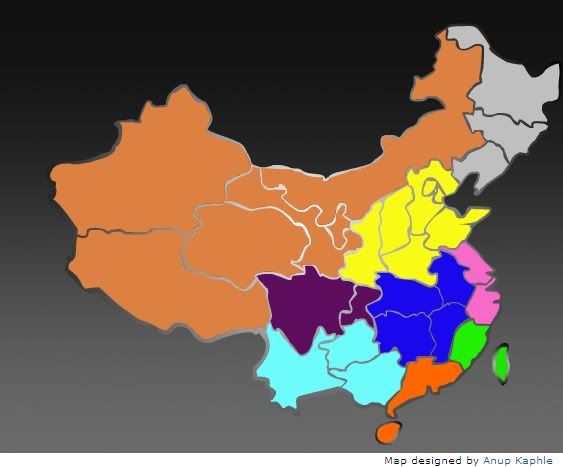
Chovanec, inspired by Joel Garreau's Nine Nations of North America, sees China as "a mosaic of several distinct regions, each with its own resources, dynamics, and historical character," and notes that "taken individually, these 'nations' would account for eight of the 20 most populous countries in the world." The nine regions are:
The Frontier (colored salmonish on the map): Population a mere 86 million. It's China's outback, or more pertinently, its Empty Quarter. Lots of wild landscapes, ethnic minorities, and exploitable resources - a milieu Americans might find faintly familiar!
The Refuge (contemplative purple): Pop. 110 million. An agricultural breadbasket consisting of the provinces of Sichuan and Chongqing, it's remote but close to self-sufficient; sheltered by high mountains, the be-pandaed region sounds like a Chinese pastoral idyll, albeit one that's now lurching somewhat gawkily into industrialization and increasing integration with the rest of China and the world.
Shangri-La (ethereal light blue): Pop. 132 million. Purported home of the legendary paradise on earth, Shangri-La is, naturally, beset by environmental degradation, drug cultivation (an historic producer of opium and, more recently, the far deadlier tobacco), and poverty: it's the poorest of the nine regions. It's also comprised of about 30% non-Han minorities.
The Yellow Land (a very yellowy yellow): Pop. 359 million. A massively fertile land watered by the Yellow River, this region has more people than the United States. It has also served as the center of Chinese political power since roughly forever; it's the real belly of the whatnot.
The Crossroads (sullen dark blue): Pop. 226 million. So named because of its geographical centrality, and because it has historically stood between regions that compete for its resources; the region's never risen to a position of dominance within China, despite its placement on the Yangtze and main transportation corridors of the country.
The Back Door (debauched orange): Pop. 112 million. Once known as Yueh, this region in the south of China was a sort of Wild South for northern elites: a place of exile, full of jungles, gambling, smuggling, shadowy secret societies, and monkey-eating. Anchored by Hong Kong, it's boomed on the back of massive exports of late; presumably becoming less awesome.
The Straits (green like money): Pop. a paltry 59 million. Formed by Fujian on the mainland and the ever-ambiguous Taiwan, the region has been primarily a sea-faring one for centuries; its colonies throughout southeast Asia still remain tied together in many ways. The Asian tiger-dom of Taiwan has driven this to become the wealthiest of China's regions, though its political future is anyone's guess.
The Metropolis (tawdry pink): Pop. 147 million. The area around Shanghai and the mouth of the Yangtze has been the one region to seize preeminence from the Yellow Land at various points in Chinese history. After a period of neglect during the years of High Communism in China, Shanghai has led the country towards what seems to be its ever more urbane, cosmopolitan, and capitalistic future.
The Rust Belt (industrial alienation gray): Pop. 109 million. This is Manchuria, the locus of a certain prickliness between Russia and Japan a century ago. Japan held the region from 1931 until World War II; it went quickly to the Communists, and it became a stronghold of the socialist state. The reform era, though, hasn't been kind to the region; parts are almost as bad off as Michigan, if you can believe it. Pastimes include grain alcohol, decline.
Chovanec's got much more in his capsule descriptions, not to mention his blog.

179 comments:
Post a Comment